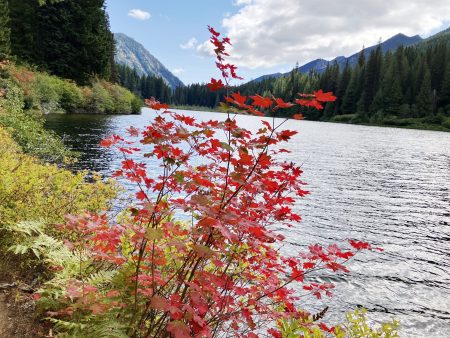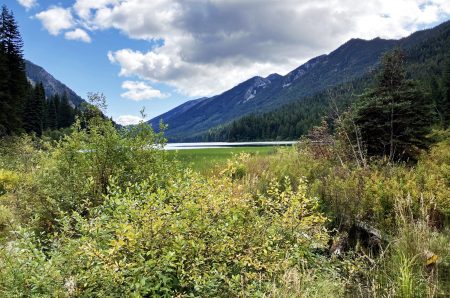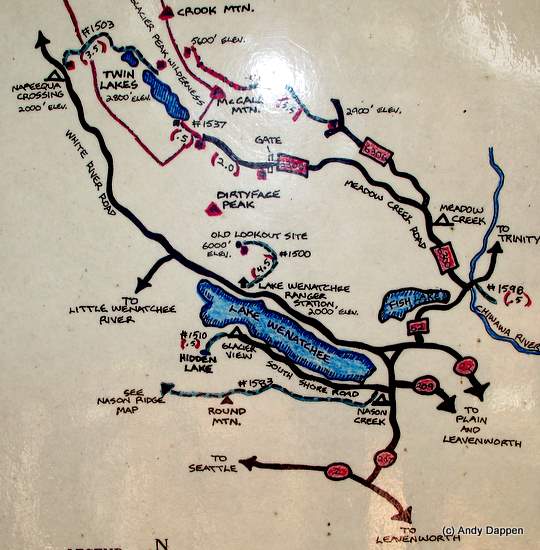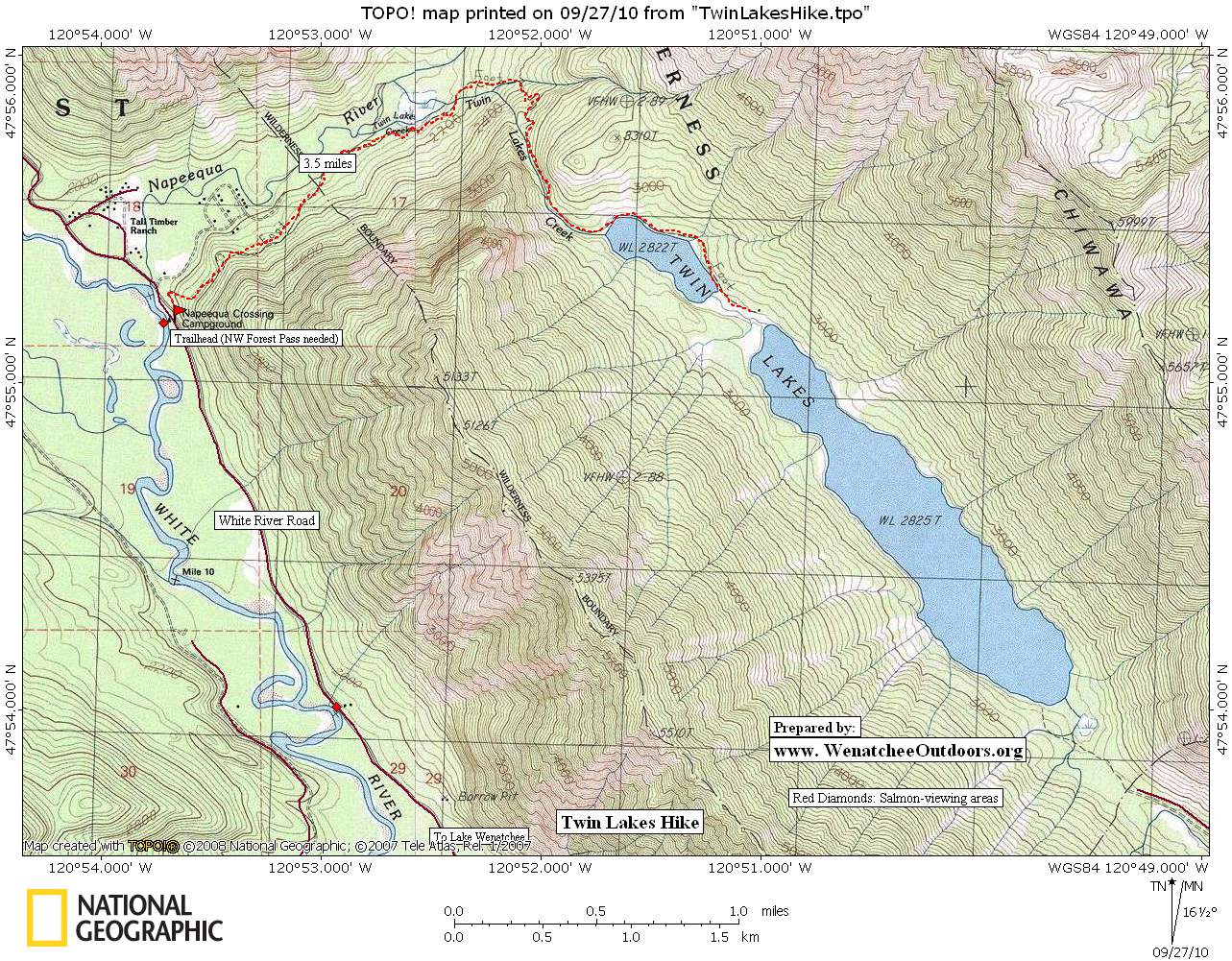![TwinLakes-25[1]](http://wenatcheeoutdoors.org/wp-content/uploads/2016/07/TwinLakes-251.jpg)
My companions were shocked I’d never hiked to Twin Lakes. “What? Mr. Outdoors hasn’t hiked this? Every outdoorsman who’s any outdoorsman has hiked this one!”
I was feeling pretty insignificant and sputtered a Swiss Cheese rational: Being a relatively short hike (3.5 miles one way), whenever I made the one-plus hour drive from Wenatchee to the upper stretches of the White River, I’ve always had a full day of hiking or climbing in mind. One of my environmental values (which, of course, is riddled with subjectivity and hypocrisy…like Swiss Cheese) is that the recreation you engage in should always be several times longer than the round trip drive getting you there.
On this September day we had already done some salmon viewing along the White River and had decided to stretch the legs a bit before returning home. The few hours remaining before nightfall would provide plenty of time for a blitz up and down the Twin Lakes Trail. Off we went.
But this trail doggedly resisted blitzing. On this drizzly autumn day the vine maples, broad leaf maples, and other deciduous leaves of the forest understory were burning with color. And mushrooms of different shapes and colors were erupting from damp dirt with such ferocity you could imagine them swelling before your eyes. I couldn’t walk more than 20 paces without drawing the camera to capture the explosions of color and fungi surrounding us.
To my companion’s annoyance our blitz became a creep. They’d walk five minutes, then wait five for me to catch up. When I’d arrive I’d skillfully deflect their frustration. “Holy Basiomycetes! Look at the mushroom spreading over your boots. Kneel down so I can get you and the ‘shroom in the same picture.”

After an hour it was apparent we weren’t making the lakes. At the rate I was not moving, we were still an hour away. At the rate I was not moving, it would be dark before we completed the round trip.
So back we went – with me dragging behind like an anchor and slowing everyone to a creep yet again. But, hey, it was a whole new viewscape walking the opposite direction through this forest of giant trees carpeted with yellow and red leaves. It was just too beautiful to speed through.
Back at the car I couldn’t help but effuse over this trail that had charmed me on virtually every step of a journey to nowhere. Unfortunately while the walk elevated my mood, it didn’t elevate my status — I’m still a nobody amongst the everybodies who have walked to Twin Lakes.

Details Details: Twin Lakes Hike (Trail 1503)
Distance: 6 miles round trip to the first lake (the smaller of the two) 7.5 miles round trip to the cabin and the second lake. Elevation Gain: 1,000 vertical feet.
Skill: 1 (beginner) . Fitness: 1+ to 2 (easy intermediate).
Activities: Hiking and trail running. No bikes, horses, or motorized use allowed. No fishing allowed.
Access. Drive west on Highway 2 from Leavenworth about 14 miles to Cole’s Corner (Milepost 84.7) and turn right onto Highway 207. Drive 4.4 miles north on Highway 207 and, at a fork in the road, stay left on the Lake Wenatchee Highway. After another 6.2 miles, fork right onto the White River Road. Drive the White River Road 6.2 miles to the Napeequa Crossing Campground (on the left side of the White River Road). About 50 yards beyond the campground, park in the small parking area on the right side of the road where the trail starts (Northwest Forest Pass required).
Map: See our topo map of this hike at the bottom of this post.

Trip Instructions. Just follow the trail to the lake (there are no junctions with other trails). The trail is moderately steep for the first few hundred yards – worry not, it levels out after a short distance and is then quite flat for about two miles. About a half mile before the first lake, the trail ramps up in steepness again.
Recommended Seasons. Spring for the flowers, summer as an escape from hot weather, and autumn for fall colors. In late spring and summer bring bug dope – the White River environs are notorious for skeets.
Salmon. The White River is one of the prime salmon rivers off the upper stem of the Columbia River. You can view sockeye here during the first few weeks of September. After the third week of ![TwinLakes-11[1]](http://wenatcheeoutdoors.org/wp-content/uploads/2016/07/TwinLakes-111.jpg) September, the spawn tapers off quickly. Sockeyes spawn in or near lakes (in this case Lake Wenatchee) and the juveniles will rear in lakes for 1 to 3 years before enrolling in the Navy and heading off to sea.
September, the spawn tapers off quickly. Sockeyes spawn in or near lakes (in this case Lake Wenatchee) and the juveniles will rear in lakes for 1 to 3 years before enrolling in the Navy and heading off to sea.
Trees. This is an interesting hike for tree huggers and tree identifiers. At the start there are stands of the usual suspects (Douglas firs and hemlocks). About 1.5 miles in, you’ll pass through a small grove of giant cedars — you’ll know them when you see them because… they’re HUGE. Farther along at about the 2,600-foot level, you’ll ascend a slope near Twin Lakes Creek with a really interesting mix of cedars, hemlocks, western white pine and douglas firs. Up at the lakes, there are some blue spruces to spice up the conifer mix. On the broad leaf side of things you’ll see broadleaf maples, vine maples, alders, balsam poplars, and osier dogwoods.
Permits. A Northwest Forest Pass is needed for the trailhead.
Misc. Twin Lakes are in the Glacier Peak Wilderness – no motorized vehicles or bikes allowed. We recommend older kids hike this one but younger kids will want to sit this one out. The trail is narrow and drops off in places.
Trip Reporter: Andy Dappen 9/26/2010. Updated 8/06/2013. Updated again on 9/30/2024 by Sarah Shaffer.
Leave It Better Than You Found It. This should be every outdoor user’s goal. Pick up trash left by others, pull some noxious weeds along your route, throw branches over unwanted spur trails, don’t ride or walk wet trails when you’re leaving ruts/footprints deeper than ¼ inch…
![TwinLakes-27[1]](http://wenatcheeoutdoors.org/wp-content/uploads/2016/07/TwinLakes-271.jpg) Disclaimer. Treat this information as recommendations, not gospel. Conditions change, and those contributing these reports are volunteers–they may make mistakes or may not know all the issues affecting a route. You are still completely responsible for your decisions, your actions, and your safety. If you can’t live with that, you are prohibited from using our information.
Disclaimer. Treat this information as recommendations, not gospel. Conditions change, and those contributing these reports are volunteers–they may make mistakes or may not know all the issues affecting a route. You are still completely responsible for your decisions, your actions, and your safety. If you can’t live with that, you are prohibited from using our information.




